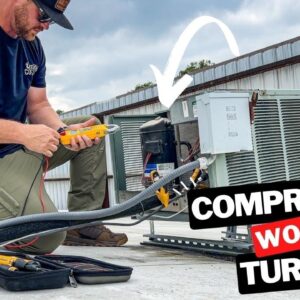Are you struggling with a compressor that refuses to turn on in your office? If so, this blog post is here to help you troubleshoot the issue and get your commercial HVAC system back up and running. We understand the frustration and inconvenience that a malfunctioning compressor can cause, especially when temperatures are rising. Whether you’re a business owner or an office manager, these troubleshooting tips will guide you in identifying the problem and potentially resolving it on your own. Keep reading to find out how to tackle this common issue and bring relief to your overheating office space.
Offices Feeling the Heat! Troubleshooting Tips for a Compressor That Refuses to Turn On | A Guide for Commercial HVAC Systems
Introduction
Are you tired of sweating in your office because the air conditioner just won’t turn on? Don’t worry, we’ve got you covered! In this guide, we will walk you through some troubleshooting tips for a compressor that refuses to turn on in commercial HVAC systems. So sit back, relax, and let’s dive into the world of HVAC troubleshooting!
Checking the Condenser for Any Issues
First things first, let’s start by checking the condenser for any issues. The condenser is the outdoor unit responsible for transferring heat from the air inside the building to the outside air. Here’s what you need to do:
- Begin by inspecting the condenser unit for any visible damage or loose wires.
- Ensure that the power supply to the condenser is not interrupted.
- If you find any debris or dirt, gently clean the condenser using a soft brush or hose.
Tripped Breaker Found and Checked for Continuity
Next, it’s time to check if there’s a tripped breaker causing the compressor to refuse to turn on. Follow these steps to verify the breaker’s continuity:
- Locate the circuit breaker panel and identify the breaker connected to the HVAC system.
- Check if the breaker is in the “on” position. If it’s in the “off” position, switch it back on.
- If the breaker keeps tripping or refuses to stay on, there might be an underlying electrical issue. In such cases, it is recommended to consult a professional electrician.
Using a Veto OC140 Case for Tool Organization
Now that we’ve covered troubleshooting tips, let’s take a moment to appreciate the importance of tool organization. One tool that we highly recommend for HVAC professionals is the Veto OC140 case. Here’s why:
- The Veto OC140 case offers ample storage space for all your HVAC tools.
- Its durable construction ensures your tools stay protected even in the toughest working conditions.
- The case features multiple pockets and compartments for easy organization and quick access to your equipment.
Showcasing Various HVAC Tools Used in the Video
In the video demonstrating troubleshooting tips for a compressor that refuses to turn on, we showcase a range of HVAC tools. These tools are essential for diagnosing and fixing any issues with your commercial HVAC system. Here are some of the must-have tools:
- Multimeter: Used to measure voltage, current, and resistance to identify electrical problems.
- Circuit Tester: Helps determine if there’s power flowing through a circuit.
- Screwdrivers: Necessary for loosening or tightening screws on various HVAC components.
- Contactor Puller: Specifically designed for safely removing and replacing contactors.
Recommending Replacement of Contactor for Safety Reasons
One common issue that can prevent a compressor from turning on is a faulty contactor. A contactor is an electromechanical switch that controls the flow of electricity to the compressor and other HVAC components. If you notice any of the following signs, we strongly recommend replacing the contactor for safety reasons:
- Burn marks or discoloration on the contactor
- Noticeable wear and tear
- Inconsistent or no voltage readings across the contactor terminals
Remember, working with electricity can be dangerous, so it’s always best to seek professional assistance when dealing with any electrical issues.
Conclusion
Having a compressor that refuses to turn on can be a frustrating experience, especially in an office setting. However, by following the troubleshooting tips mentioned in this guide, you’ll be well-equipped to identify and resolve common issues with your commercial HVAC system. Remember, safety should always be a priority, so don’t hesitate to consult a professional if you’re unsure or uncomfortable with any electrical work.
FAQs
Q1. How often should I clean the condenser unit?
A1. It is recommended to clean the condenser unit at least once a year to ensure optimal performance and prevent any blockages.
Q2. Can I replace the contactor myself?
A2. While it is possible to replace the contactor yourself, we strongly advise seeking professional assistance due to the electrical risks involved.
Q3. Are there any other common issues that can prevent a compressor from turning on?
A3. Yes, other common issues include faulty capacitors, low refrigerant levels, and malfunctioning thermostats.
Q4. Should I turn off the power before inspecting the condenser?
A4. Absolutely! Before inspecting the condenser or performing any electrical work, it is crucial to switch off the power supply to avoid any accidents.
Q5. Where can I find high-quality HVAC tools?
A5. You can find a wide selection of HVAC tools at truetechtools.com. Don’t forget to use the promo code “quality HVAC” at checkout for an 8% discount!
(Note: Always consult a professional HVAC technician for accurate diagnosis and repairs. The information provided in this article serves as a general guide and should not replace professional advice.)

